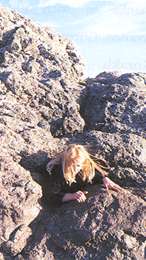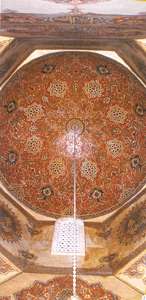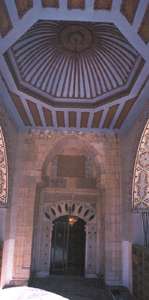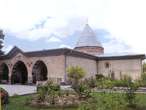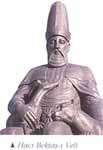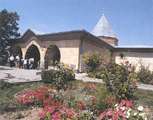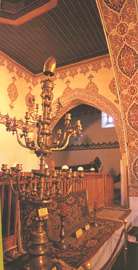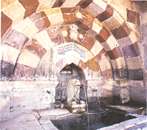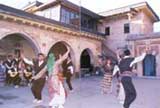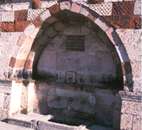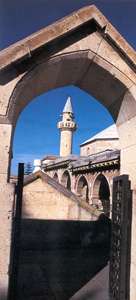
Hotel reservation Flight bookingWeather reports
|
The stamp of Haci Bektas-i Veli's imprint upon Turkish, Islamic, and world history is deep and unmatched. Let us, therefore, attempt to become acquainted with and develop a sense for his world, filled as it is with love for humanity and for the universe, never forgetting that this is the path of love, the path of peace, the path of knowledge, the path of belief. In Khorasan's city of Nishabur, most likely in the years between 1243 and 1248, a son was born to Seyyid Ibrahim Sani and his wife Hatern Hatun, the daughter of Sheik Ahmet. His mother's compassion and his father's love for equality and humanity were the foundations upon which his upbringing was based and such sentiments informed and enriched his boyhood years. His studies under the tutelage of Hoca Ahmet Yesevi of Turkestan equipped him with a knowledge of positive scielices and in the school of his illustrious philosopher-mentor, he studied mathematics and physics along with literature and philosophy. Under Sheik Lokman Perende, one of Ahmet Yesevi's successors, he studied mysticism. From the works of the poet Omar Khayyam, Feridettin Attar, and Sheik Numan he took his inspiration. Khorasan possessed a vast cultural heritage that had nourished many a scholar and philosopher. Haci Bektas-i Veli completed his studies in Khorasan, acquiring from them a broad and genial view of the world. His education encouraged this young Islamic mystic to become better acquainted with humanity, and Haci Bektas-i Veli began to seek the fire of infinite love within himself. Becoming a well-known Sufi, he set out from Khorasan to make the pilgrimage to Mecca. Leaving Mecca, he traveled to Syria and then continued his journeys in Persia, Iraq, and Arabia. During these years, Anatolia was in a state of severe political and economic disarray. Haci Bektas-i Veli was affected by this situation and came to Anatolia with the idea of restoring fragmented Turkish unity, and took part in the effort to make the peninsula a Turkish and Muslim homeland. At length, Haci Bektas-i Veli reached Sulucakarahoyuk, the historical and cultural center of the Kirsehir Akhis located in the heart of the Cappadocia region. Forty kilometers from Kirsehir, this is the town and county of the Nevsehir province, known today as Hacibektas. Even before Haci Bektas-i Veli's arrival, the town and region that he had chosen to make his home had had a rich and varied past. The first human settlement in the area is as early as Neolithic times, and the Hattis, Hittites, Mushkis (a name used by Assyrians for those who came from the west), the successors of Alexander the Great, Phrygians, Galatians, Romans, Byzantines, and Turks have all successively dwelt in this historical area and left their own, permanent traces upon it. The Turkish-Islamic mystic decided to settle down in this place that had made a deep impression on him some time between 1275 and 1280. After the Muslim philosopher took up residence at Sulucakarah6yijk, Hacim Koy, a small nearby hamlet of some seven hearths, began to grow and develop. In Anatolia, these were the years when the Mongol invaders were advancing and extending their control everywhere, years of political and economic crises unattended by rulers who wasted their energies fighting with each other over doomed and worth- less thrones. It is in the context of such adversities and chaos that Haci Bektas-i Veli developed his philosophy and decided to establish his own great haven of knowledge. Pupils flocked to him and the wisdom that he imparted to them was based on four fundamental tenets to be achieved in a sequence of steps: Love of God: A person attains true maturity and peace only through the love of God. They cannot be achieved in any other way. Focus on substance rather than on the superficial: Deep wisdom and the knowledge of things related to God are special favors granted by God to those whom He chooses. God never looks at the external manifestations of the things you do but rather at your intentions when you do them. Love and unity among people: The goods of this world gain a person nothing. The only two things that illuminate one's way are divine and human love. Those who reach the world of the hereafter realize this fact once they've arrived there, but those of this world have no understanding of what will be valuable in the next. The highest attainable degree is the one achieved by a loving heart. The power of sanctity: One should cease to seek God in this place or that. if a person believes that he has achieved sufficient maturity and if he trusts the power of his vision, he should stop gazing around like an absent-minded astrologer viewing the heavens. What is being sought is not up but within, buried beneath a person's external appearance. As may be seen from these stages of Haci Bektas-i Veli's instruction, this is a philosophical system based upon the principles of tolerance and love of humanity. Cappadocia, which was a major center of Christianity, was rather deeply influenced by this thinker's philosophy. The principles and elements of Haci Bektas-i Veli's philosophy and life became the foundation on which the Bektashi dervish order developed. Bektashism was based on four tenets or "doors": the Door of the Shariah (Religious Law), the Door of Mysticism, the Door of Truth, and the Door of Spiritual Knowledge. In their Ceremony of Confession, Bektashis vowed to be responsible "for their hands" (the things they do), "for their loins" (their desires), and "for their tongues" (what they say). This vow was a powerful and meaningful expression of the belief that one's should be channeled towards love and respect. Love of God and love of man lie at the foundation of Haci Bektas-i Veli's philosophy. In this philosophy, the mystic examined the universe that the Creator had created. Rules that nature had determined millions of years ago were just as applicable as ever in an infinity in which courtesy and savagery embraced. Since it came into being, humanity has been the greatest observer of a perfect order. In this world, there is a securely anchored chain of rule and order. Haci Bektas-i Veli was deeply influenced by the perfection, harmony, and order that he observed in the universe. After all such questioning, the substance of Haci Bektas-i Veli's philosophy converges upon a single point: the spirit that ensures the integrity of the body always inclines towards love in its harmony with nature, and because of this tendency, achieving divine truth through love becomes inevitable. Love of God, of the universe, and of humanity is, thus, the essence of his philosophy and in his dictum "The end of the road that does not pass through knowledge is darkness" he also provided the underpinning for his philosophy. in his view, the world has been entrusted into the hands of human beings, all of whom are brothers. At its heart, the philosophy of Haci Bektas-i Veli incorporates the same substance as the Universal Declaration of Human Rights of 1948. Haci Bektas-i Veli's contributions to achieving unity among the Turks of Anatolia were crucially important. Expressing himself in the language of the common folk in order to make himself understood to as wide an audience as possible, he was instrumental in ensuring that the core of the Turkish language would survive. Henceforth Turkish, and not Arabic or Persian, became the language of scholarship and instruction and the language of ritual and court. Turkish folk tunes became composed songs and were sung in Turkish accompanied by traditional Turkish instruments. His efforts to protect Turkish language and culture from alien influences continued until Haci Bektas-i Veli's dying breath. The unifying and exalting principles that he incorporated into his teachings became principles, which devoid of any bigotry or fanaticism were perfectly suited to the times. •Seek and find. Do not hurt even if you are hurt yourself. •Educate your women. Control your deeds, tongue, and desires. •Whatever you seek, look for it in yourself. The adept are both pure and purifying. •The first step of a talent is modesty. A person's perfection lies in the beauty of what he says. •Condemn no nation or person. Do not impose on someone that which is too burdensome for him to bear. •The end of the road that does not pass through knowledge is darkness. How glad for those who shed light into the darkness of thought. • Prophets and saints are God's gift to humanity. These words, which best sum up the philosophy of Haci Bektas-i Veli, are of vital importance to the whole world. Haci Bektas-I Veli believed that men and women should take part in daily life and worship together. One of the best examples of this belief, one that survives even today, is in the ritual dancing in which men and women worship God together with music and with bodily movements matching that music. This ritual is one of the fundamental forms of worship whereby it is possible to turn to and reach God. Feelings well up sincerely through bodily movements without any conscious concern for aesthetic considerations and beautifully manifest themselves. This ritual is a living cultural heritage handed down from generation to generation for centuries. Haci Bektas-i Veli took a great interest in the fine arts and regarded them with compassion. The things that he taught in his convent were not empty words to remain in the classroom, but instead were to be applied to one's life. He was the author of a number of works that made great contributions to the scholarship and philosophy of the Turkish-Islamic world. Of these, Velayetname, an autobiographical account of his teachings and thoughts, is regarded as his most important work. The teachings and philosophy of life of Haci Bektas-i Veli, holy man from Khorasan, enveloped all of Anatolia like a strong and loving embrace. The common-folk had an enormous love and respect for this famous mystic, who called upon all believers to come together and join in the worship of God. He was present at the ceremonies held when Orhan, the second in the line of Ottoman sultans, ascended the throne. As a young man, Orhan had been deeply influenced by the great mystic's teachings. Paying a visit to the mystic's convent, he asked Haci Bektas-i Veli for his blessing upon a new military corps that he had founded. Under the Ottomans, the disunity of the Anatolian Turks was brought to an end and Haci Bektas-i Veli's pioneering efforts in the areas of religion, language, art, and social services played a key role in achieving this target. Just as we are unsure about the date of this great mystic's birth, the date of his death is uncertain as well, but he probably met his Maker in 1337. He was buried in a tomb located amidst a clutch of buildings in Hacibektas county that now serve as the Haci Bektas-i Veli Museum. The tomb building has seven doors, each one of which is somewhat larger than the one before it. This is said to symbolize maturity and humility. THE FIRST COURTYARD, which used to be called the Nadar Courtyard, is entered through the monumental Catal (Fork) Gate on the southern side. Immediately to the right of the entrance is the Ucler fountain, decorated with a seal-of-Solomon motif that was donated by Fatma Nuriye, the wife of Grand Vizier Halil Pasha in 1902, when the convent was headed by Feyzullah Dedebaba. Originally this courtyard contained a number of service-structures such as a stable, a bakery, a bath, a latrine, a guesthouse, and a laundry, none of which have survived. THE SECOND COURTYARD, which used to be called the Dergah Courtyard, is entered through the Ucler (Threes) Gate with its triangular pediment and pointed arch. Unlike its predecessor, most of this courtyard's structures have survived. Starting from the right, there are a fountain, the quarters of the head of the refectory, a refectory, and the convent's mosque; in the center is a pool and on the left, a guest-house, a meeting-hall, a larder, and the quarters of the convent's leader. Arslanli Cesme The statue of a lion on this fountain (the name means "Fountain with a Lion") is carved in Alexandrine marble in the style of Classical Egyptian art. It was donated to the convent in 1875 by Fatma Hanim, a descendent of the Ottoman governor of Egypt, Kavalali Mehmet Ali Pasha. The fountain in which the statue was set to 1554 and was donated in the name of Malkoc Bali Bey, a governor of Silistre. Asevi Baba Kosku, "Asevi" means "refectory" and in the convent's protocol, the head (baba) of the refectory ranked second in importance only to the dedebaba, the head of the convent. Today the structure serves as the museum's administrative office. Refectory According to an inscription, this refectory was erected in 1560 and is another donation in the name of Malkoc Bali Bey. On display are the famous huge black cauldron, smaller cauldrons, and other kitchen utensils. Tekke Cami This mosque was built in 1834 by Sultan Mahmud II. Despite its late date, the mosque is in a very conservative style. From the inside one can see that it is roofed with a dome; but outside, the dome is concealed by a low conical cap sheathed with lead. The rather stubby minaret is not original; it is the result of restoration work. Pool This pool, located directly opposite to the entrance, has an inscription indicating that it was built in 19o6-1908 by Nazli Hatun, the wife of H. Mat Pasha, the governor of Beirut. The southern facade has a triangular pediment surmounted by a twelve-lobed Huseyni crown. An ancient column capital in the Corinthian order was used to support the fountain's jets. Mihmanevi This guesthouse ("mihman" means "guest") was where visitors were put up when the convent was active. Today it is used as the museum's depot. Meydanevi The convent's meetinghouse or auditorium was one of its most important units, for it is where all the important ceremonies such as admission, promotion, etc were held. According to the inscription, it was originally constructed in 1367 by Sultan Murad I but it has undergone much rebuilding and restoration since. The construction technique employed in the ceiling of the main hall is particularly interesting. On display here are hides symbolizing the twelve stages of the order, calligraphic plates, the Bektashi throne, musical instruments, paintings, old black-and-white photographs, seals, and a variety of objects of an ethnographic nature. Kilerevi This two-storied building had a dual function. The ground floor was the convent's larder and was where food and other supplies were stored. The upper story served as the residence of the convent's leader. Today, the building is used as a depot for the library. THE THIRD COURTYARD also used to be called the Hazret Courtyard. It is entered through the green-paneled Altilar (Sixes) Gate, which is surmounted by a low arch. One corner of the courtyard is laid out as a small museum commemorating Ataturk's visit; other elements include Pirevi, the Tomb of Balim Sultan, and a cemetery. Ataturk Kosesi This is a small museum located immediately to the right of the entrance. It commemorates Mustafa Kemal Pasha's visit to the convent on 22 December 1919 after the Sivas Congress. Pirevi Standing directly opposite to the entrance is Pirevi, the House of the Founder,being a complex of structures to which additions were made between the 13th and 16th centuries. On the left and right of the entrance are the graves of the babas (literally "fathers", sheiks) and dedes ("grandfathers", senior sheiks) who served at the convent. The elaborate marble portal, called Akkapi, leads into the central hall (Orta Medhal), which is decorated with painting. At the right is the Cilehane (the Cell of the Ordeal, also known as Kizilcahalvet or "Fiery Furnace"). This is the core of the convent for it is where novices underwent their ordeals before admission to the order. A rather modest-looking doorway leads into Kirklar Meydani, the Hall of the Forty, with its wooden ceiling and painted wall decorations. The famous Kirkbudak (Forty Branches) candelabrum may be of Indian origin and was probably a gift to the convent. Also on display are a chapter from the Quran in the handwriting of Caliph Ali, a silk carpet presented by the Shah of Iran, banners, sets of cups, the original silver door of the Haci Bektas-i Veli tomb, a few weapons, and various objects of an ethnographic nature that are associated with the culture and practices of the Bektashis. The graves of the Khorasan dervishes stand on the eastern side of this hall and those of the (Celebis (Mevlevi leaders) are located to the west. A modestly sized hut decorative marble door (known also as Gokesik, "Heavenly") leads into the Abode of the Founder, which is to say the Tomb of Haci Bektas-i Veli. The building is constructed in the Seljuk style of architecture and its domes and walls are decorated with paintings. The tall sarcophagus is draped in green cloths. From outside, the tomb appears to be roofed with a tall, conical cap sheathed in lead. The Tomb of Guvenc Abdal (abdal being a rank in the dervish order) contains the graves of Guvenc, his wife Dunya Guzeli, and their servants. The tomb is roofed with a vault whose decorations are not original. Balim Sultan Turbesi On the right side of the courtyard is another funeral structure in the Seljuk style of architecture, this one roofed with a pyramidal cap. A novice in the Bektashi convent in Dimetoka, Balim Sultan later joined this convent and performed a number of important services on behalf of the Bektashi order. For that reason, he is referred to among Bektashis as Pir-i Sani or the Second Founder. In addition to the grave of Balim Sultan, this tomb also contains the grave of Kalender Shah. The tomb itself was built in 1519, three years after Balim Sultan's death, by Sheiksuvar Ali Bey, the head of the Dulkadiroglu clan and one of Selim I's military commanders. The interior of the dome and the walls of the tomb are decorated with paintings. On display are a candelabrum, the original door, and a number of calligraphic plates. The venerable-looking black mulberry tree (Morus nigra) before the tomb is a "wishing tree": According to an old tradition, those who came to pray at the tomb bound a strip of cloth to a branch of this tree in the belief that their prayers would be granted. Cemetery The cemetery immediately next to the Tomb of Balim Sultan is the resting-place of dervishes who served at the convent. The different styles of headgear surmounting the tombstones indicate the particular sect to which the occupant of the grave belonged and all are unique examples of Turkish-Islamic art. OTHER PLACES OF INTEREST The Museum of Archaeology and Ethnography This museum is located in the center of town about a hundred meters west of the Haci Bektas-i Veli Museum. On display are archaeological finds discovered during systematic excavations conducted at Sulucakarah6ybk in 1967-1976. The museum is rather important because all the finds are from the Sulucakara mound. It is open every day except Monday. Kadincik Ana Evi This was the house of Kadincik Ana, a woman mentioned in Velayetname and a personage of some importance among Bektashis. It is closed to the public but permission to visit it can be obtained from the directorate of the museum. Bektas Efendi Turbesi Bektas Efendi, the occupant of this tomb, died in 1603 but little is known about him. The tomb's dome and walls are decorated with paintings. The building is typical of the style of Seljuk-period tomb architecture. Cilehane-Deliklitas This is a cave located on Mt Arafat three kilometers east of town, which, according to some, was used by Haci Bekta@-i Veli as an ordeal cell. A local popular belief holds a person who passes through the hole in the rock will be purged of his sins. Also on the hill are a sacred spring, the Hact Bektas-i Veli, Yunus Emre, and Ozanlar (Bards) monuments, and a theater seating 5,000 people. Bestaslar This site is located near Civril village about five kilometers north of town. The five huge rocks (Bestaslar means "Five Rocks") are geologically unusual and there is a legend told about them that is related in detail in Velayetname. Ataturk Evi The Ataturk House is where Mustafa Kemal Pasha stayed during his visit here on 22-23 December 1919. Originally constructed in the 19th century, the building is to be opened to the public as a museum after it has been restored. EXCURSION SPOTS Dedebagi and Hanbagi are enticingly lovely recreational areas for picnics. Hacibektas county is a part of the province of Nevsehir, a tourism paradise in its own right. Located in the heart of ancient Cappadocia, Nevsehir is an open-air museum thanks to such not-to-be-missed sites as Uchisar, Avanos, Goreme, Urgup, Zelve, Derinkuyu, Gulsehir, and Kozakli. Everywhere you look in Nevsehir and its counties you will find history, nature, and local culture intimately intermingled. Churches that were important in the history of Christianity, underground cities, and fantastic valleys and fairy chimneys that are wonders of nature will keep you entranced as you explore them. Hikes through the Cappadocia region will give you a chance to become familiar with it. Trips made hundreds of meters off the ground in colorful hot-air balloons over this magical region are an experience you will never forget. Beneath a cerulean sky, the white clouds seem close enough to touch. Below, you may observe fairy chimneys with pigeons fluttering around them, mysterious valleys linked to one another, and rock and cliffs worked into sinuous, and fantastic shapes by the elements. Cappadocia is an art gallery in which Mother Nature has displayed all her talents and holds visitors spellbound in her thrall. |

